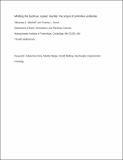Melting the hydrous, subarc mantle: the origin of primitive andesites
Author(s)
Mitchell, Alexandra L; Grove, Timothy L.
Download410_2015_1161_ReferencePDF.pdf (977.2Kb)
OPEN_ACCESS_POLICY
Open Access Policy
Creative Commons Attribution-Noncommercial-Share Alike
Terms of use
Metadata
Show full item recordAbstract
This experimental study is the first comprehensive investigation of the melting behavior of an olivine + orthopyroxene ± spinel—bearing fertile mantle (FM) composition as a function of variable pressure and water content. The fertile composition was enriched with a metasomatic slab component of ≤0.5 % alkalis and investigated from 1135 to 1470 °C at 1.0–2.0 GPa. A depleted lherzolite with 0.4 % alkali addition was also studied from 1225 to 1240 °C at 1.2 GPa. Melts of both compositions were water-undersaturated: fertile lherzolite melts contained 0–6.4 wt% H[subscript 2]O, and depleted lherzolite melts contained ~2.5 wt% H[subscript 2]O. H[subscript 2]O contents of experimental glasses are measured using electron microprobe, secondary ion mass spectrometry, and synchrotron-source reflection Fourier transform infrared spectroscopy, a novel technique for analyzing H[subscript 2]O in petrologic experiments. Using this new dataset in conjunction with results from previous hydrous experimental studies, a thermobarometer and a hygrometer–thermometer are presented to determine the conditions under which primitive lavas were last in equilibration with the mantle. These predictive models are functions of H[subscript 2]O content and pressure, respectively. A predictive melting model is also presented that calculates melt compositions in equilibrium with an olivine + orthopyroxene ± spinel residual assemblage (harzburgite). This model quantitatively predicts the following influences of H[subscript 2]O on mantle lherzolite melting: (1) As melting pressure increases, melt compositions become more olivine-normative, (2) as melting extent increases, melt compositions become depleted in the normative plagioclase component, and (3) as melt H[subscript 2]O content increases, melts become more quartz-normative. Natural high-Mg# [molar Mg/(Mg + Fe[superscript 2+])], high-MgO basaltic andesite and andesite lavas—or primitive andesites (PAs)—contain high SiO2 contents at mantle-equilibrated Mg#s. Their compositional characteristics cannot be readily explained by melting of mantle lherzolite under anhydrous conditions. This study shows that experimental melts of a FM peridotite plus the addition of alkalis reproduce the compositions of natural PAs in SiO[subscript 2], Al[subscript 2]O[subscript 3], TiO[subscript 2], Cr[subscript 2]O[subscript 3], MgO, and Na[subscript 2]O at 1.0–1.2 GPa and H[subscript 2]O contents of 0–7 wt%. Our results also suggest that PAs form under a maximum range of extents of melting from F = 0.2–0.3. The CaO contents of the melts produced are 1–5 wt% higher than the natural samples. This is not a result of a depleted source composition or of extremely high extents of melt but is potentially caused by a very low CaO content contribution from deeper in the mantle wedge.
Date issued
2015-07Department
Massachusetts Institute of Technology. Department of Earth, Atmospheric, and Planetary SciencesJournal
Contributions to Mineralogy and Petrology
Publisher
Springer Berlin Heidelberg
Citation
Mitchell, Alexandra L., and Timothy L. Grove. “Melting the Hydrous, Subarc Mantle: The Origin of Primitive Andesites.” Contributions to Mineralogy and Petrology 170.2 (2015): n. pag.
Version: Author's final manuscript
ISSN
0010-7999
1432-0967